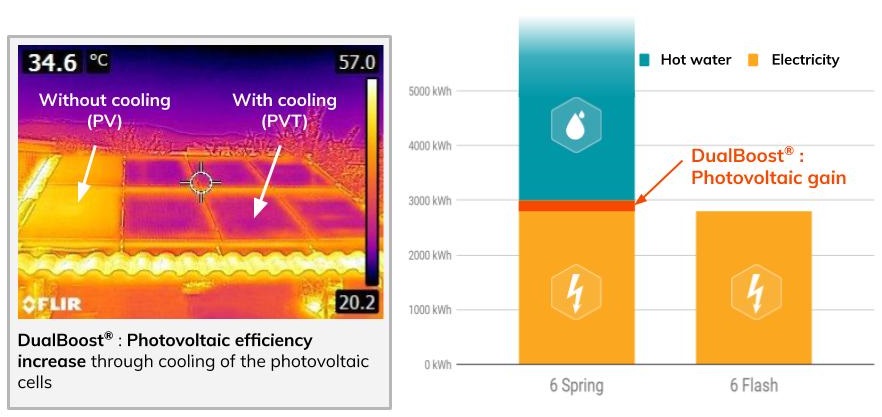What is the photovoltaic production gain with Dualsun SPRING panels?
First of all, it is important to note that most photovoltaic panels are designed to withstand temperatures of – 40°C to + 85°C and can therefore exceed 50°C on the surface in the hottest months. They have no risk related to overheating, but it should be noted that the panel gradually loses performance beyond a surface temperature of 25°C of approximately 0.35% per degree of temperature rise. cells.
For example, a PV solar panel that has a power of 400W at 25°C, will have a power of 398.6 W at 26°C and 379 W at 40°C.
It is an intrinsic property of photovoltaic cells whose voltage decreases with the rise in temperature.
This is due to the fact that the operating voltage of the PV cells decreases significantly as the temperature rises.
One of the advantages of Dualsun hybrid panels is that they absorb the wasted heat of the photovoltaic cells through the heat exchanger on the backside of the panel and in effect lower the temperature of the PV cells. This cooling effect allows to increase the PV power output and thus increase PV production by 5% to 15% as compared to a standard PV panel in the same conditions.
We have used a thermal camera to demonstrate the cooling effect on the temperature of the cells:
The circulation of water leads to cooling of the photovoltaic panels.
The 2 panels on the left in the picture above are standard photovoltaic panels.
The 6 panels on the right in the picture above are Dualsun SPRING panels.
There is a difference of about 20°C between the photovoltaic and hybrid panels, i.e. a power gain of about 7%.
This homogenous fluid circulation in the exchanger leads to a cooling of the entire surface of the photovoltaic cells. The temperature gradient with good sunshine (800W/m²) is about 2°C per panel for a flow rate of 200L/h: it allows the heat to be evacuated efficiently.
The power gain depends on the type of application, it is estimated that the efficiency improvement due to cooling is around :
The graph below shows the influence of the temperature of a photovoltaic panel on its voltage and intensity, and therefore its power (Power = Voltage * Intensity). It can be seen that the decrease in the temperature of the module leads to an increase in the output voltage but has almost no impact on the current.
In the case of an installation with a centralized inverter, hybrid panels can therefore be placed in series with conventional photovoltaic panels without reducing the DualBoostⓇ effect because outputs voltage of the panels will add up.
>To go further : What happens if the water stagnates in the panels? Is there a risk of overheating?

